Using Multiscale Molecular Modeling to Analyze Possible NS2b-NS3 Protease Inhibitors from Philippine Medicinal Plants
Abstract
:1. Introduction
2. Materials and Methods
2.1. Test for Pharmacological Viability
- •
- Absorption: High gastrointestinal (GI) absorption, as predicted by Lipinski and Egan filters;
- •
- Distribution: Suitable bioavailability and favorable blood–brain barrier (BBB) permeability, indicated by passing the Veber and Ghose filters;
- •
- Metabolism: Predicted to be non-substrate and non-inhibitor for major cytochrome P450 enzymes, ensuring minimal metabolic interactions, guided by Lipinski and Muegge filters;
- •
- Excretion: Favorable excretion profiles with reasonable half-life and low potential for accumulation, supported by Lipinski and Muegge filters.
2.2. Molecular Docking
2.3. Molecular Dynamics Simulation
2.4. Molecular Mechanics/Poisson–Boltzmann Surface Area (MM/PBSA) Analysis
3. Results
3.1. Biocompatibility and Toxicity Test Results
3.2. Docking Results
3.3. Molecular Dynamics Simulation Results
4. Discussion
4.1. Biocompatibility and Toxicity Test
4.2. Molecular Docking
4.3. RMSD Analysis of Protein–Ligand Complex
4.4. RMSD Analysis of Ligands Only as the Reference Point
4.5. RMSD Analysis of Active Site Residues and Ligand
4.6. RMSF Analysis
4.7. Interacting Residues after MD Simulation
4.8. Molecular Mechanics Poisson–Boltzmann Surface Area (MM/PBSA) Analysis
4.9. Final NS2b-NS3 Protease–Ligand Complex Structures after Simulation
5. Conclusions
Supplementary Materials
Author Contributions
Funding
Institutional Review Board Statement
Informed Consent Statement
Data Availability Statement
Acknowledgments
Conflicts of Interest
References
- Amir-Hassan, A.; Lee, V.S.; Baharuddin, A.; Othman, S.; Xu, Y.; Huang, M.; Yusof, R.; Rahman, N.A.; Othman, R. Conformational and energy evaluations of novel peptides binding to dengue virus envelope protein. J. Mol. Graph. Model. 2017, 74, 273–287. [Google Scholar] [CrossRef] [PubMed]
- Villanueva, R. Philippines Logs 220,705 Dengue Cases in 2022. The Philippine Star, 17 January 2023. Available online: https://www.philstar.com/nation/2023/01/17/2238093/philippines-logs-220705-dengue-cases-2022(accessed on 20 March 2023).
- Aguiar, M.; Stollenwerk, N. Dengvaxia: Age as surrogate for serostatus. Lancet Infect. Dis. 2018, 18, 245. [Google Scholar] [CrossRef] [PubMed]
- Padmapriya, P.; Fathima, S.G.; Ramanathan, G.; Yuvaraj, V.; Kaveri, K.; Gunasekaran, P.; Sivagnanam, U.T.; Thennarasu, S. Development of antiviral inhibitor against dengue 2 targeting Ns3 protein: In vitro and in silico significant studies. Acta Trop. 2018, 188, 1–8. [Google Scholar] [CrossRef] [PubMed]
- Uday, R.V.S.; Misra, R.; Harika, A.; Dolui, S.; Saha, A.; Pal, U.; Ravichandiran, V.; Maiti, N.C. Dabrafenib, idelalisib and nintedanib act as significant allosteric modulator for dengue NS3 protease. PLoS ONE 2021, 16, e0257206. [Google Scholar] [CrossRef] [PubMed]
- Abduraman, M.A.; Hariono, M.; Yusof, R.; Rahman, N.A.; Wahab, H.A.; Tan, M.L. Development of a NS2B/NS3 protease inhibition assay using AlphaScreen® beads for screening of anti-dengue activities. Heliyon 2018, 4, e01023. [Google Scholar] [CrossRef] [PubMed]
- Erbel, P.; Schiering, N.; D’Arcy, A.; Renatus, M.; Kroemer, M.; Lim, S.P.; Yin, Z.; Keller, T.H.; Vasudevan, S.G.; Hommel, U. Structural basis for the activation of flaviviral NS3 proteases from dengue and West Nile virus. Nat. Struct. Mol. Biol. 2006, 13, 372. [Google Scholar] [CrossRef] [PubMed]
- Da Silva-Júnior, E.F.; De Araújo-Júnior, J.X. Peptide derivatives as inhibitors of NS2B-NS3 protease from Dengue, West Nile, and Zika flaviviruses. Bioorg. Med. Chem. 2019, 27, 3963–3978. [Google Scholar] [CrossRef] [PubMed]
- Perera, S.D.; Jayawardena, U.A.; Jayasinghe, C.D. Potential Use of Euphorbia hirta for Dengue: A Systematic Review of Scientific Evidence. J. Trop. Med. 2018, 2018, 2048530. [Google Scholar] [CrossRef] [PubMed]
- Yildiz, M.; Ghosh, S.; Bell, J.A.; Sherman, W.; Hardy, J.A. Allosteric Inhibition of the NS2B-NS3 Protease from Dengue Virus. ACS Chem. Biol. 2013, 8, 2744–2752. [Google Scholar] [CrossRef]
- Hanwell, M.D.; Curtis, D.E.; Lonie, D.C.; Vandermeersch, T.; Zurek, E.; Hutchison, G.R. Avogadro: An advanced semantic chemical editor, visualization, and analysis platform. J. Cheminform. 2012, 4, 17. [Google Scholar] [CrossRef]
- Schrödinger. Schrödinger Release 2019-3; Maestro, Schrödinger LLC: New York, NY, USA, 2019. [Google Scholar]
- Šali, A.; Blundell, T.L. Comparative protein modelling by satisfaction of spatial restraints. J. Mol. Biol. 1993, 234, 779–815. [Google Scholar] [CrossRef] [PubMed]
- Guex, N.; Peitsch, M.C. SWISS-MODEL and the Swiss-PdbViewer: An environment for comparative protein modeling. Electrophoresis 1997, 18, 2714–2723. [Google Scholar] [CrossRef] [PubMed]
- Kim, S.; Chen, J.; Cheng, T.; Gindulyte, A.; He, J.; He, S.; Li, Q.; Shoemaker, B.A.; Thiessen, P.A.; Yu, B.; et al. PubChem 2023 update. Nucleic Acids Res. 2023, 51, D1373–D1380. [Google Scholar] [CrossRef] [PubMed]
- Tung, C.-W. Public databases of plant natural products for computational drug discovery. Curr. Comput.-Aided Drug Des. 2014, 10, 191–196. [Google Scholar] [CrossRef] [PubMed]
- Macalalad, M.A.B.; Gonzales, A.A., III. In Silico Screening and Identification of Antidiabetic Inhibitors Sourced from Phytochemicals of Philippine Plants against Four Protein Targets of Diabetes (PTP1B, DPP-4, SGLT-2, and FBPase). Molecules 2023, 28, 5301. [Google Scholar] [CrossRef] [PubMed]
- Daina, A.; Michielin, O.; Zoete, V. SwissADME: A free web tool to evaluate pharmacokinetics, drug-likeness and medicinal chemistry friendliness of small molecules. Sci. Rep. 2017, 7, 42717. [Google Scholar] [CrossRef] [PubMed]
- Athanasiadis, E.; Cournia, Z.; Spyrou, G. ChemBioServer: A web-based pipeline for filtering, clustering and visualization of chemical compounds used in drug discovery. Bioinformatics 2012, 28, 3002–3003. [Google Scholar] [CrossRef] [PubMed]
- Lipinski, C.A.; Lombardo, F.; Dominy, B.W.; Feeney, P.J. Experimental and computational approaches to estimate solubility and permeability in drug discovery and development settingsq. Adv. Drug Deliv. Rev. 2001, 46, 3–26. [Google Scholar] [CrossRef] [PubMed]
- Ghose, A.K.; Viswanadhan, V.N.; Wendoloski, J.J. A Knowledge-Based Approach in Designing Combinatorial or Medicinal Chemistry Libraries for Drug Discovery. 1. A Qualitative and Quantitative Characterization of Known Drug Databases. J. Comb. Chem. 1999, 1, 55–68. [Google Scholar] [CrossRef]
- Veber, D.F.; Johnson, S.R.; Cheng, H.-Y.; Smith, B.R.; Ward, K.W.; Kopple, K.D. Molecular properties that influence the oral bioavailability of drug candidates. J. Med. Chem. 2002, 45, 2615–2623. [Google Scholar] [CrossRef]
- Egan, W.J.; Merz, K.M.; Baldwin, J.J. Prediction of Drug Absorption Using Multivariate Statistics. J. Med. Chem. 2000, 43, 3867–3877. [Google Scholar] [CrossRef] [PubMed]
- Muegge, I.; Heald, S.L.; Brittelli, D. Simple Selection Criteria for Drug-like Chemical Matter. J. Med. Chem. 2001, 44, 1841–1846. [Google Scholar] [CrossRef] [PubMed]
- Morris, G.M.; Huey, R.; Lindstrom, W.; Sanner, M.F.; Belew, R.K.; Goodsell, D.S.; Olson, A.J. AutoDock4 and AutoDockTools4: Automated docking with selective receptor flexibility. J. Comput. Chem. 2009, 30, 2785–2791. [Google Scholar] [CrossRef] [PubMed]
- Shamsian, S.; Sokouti, B.; Dastmalchi, S. Benchmarking different docking protocols for predicting the binding poses of ligands complexed with cyclooxygenase enzymes and screening chemical libraries. Bioimpacts 2023, 14, 29955. [Google Scholar] [CrossRef] [PubMed]
- De Sousa, L.R.F.; Wu, H.; Nebo, L.; Fernandes, J.B.; Da Silva, M.F.D.G.F.; Kiefer, W.; Kanitz, M.; Bodem, J.; Diederich, W.E.; Schirmeister, T.; et al. Flavonoids as noncompetitive inhibitors of Dengue virus NS2B-NS3 protease: Inhibition kinetics and docking studies. Bioorg. Med. Chem. 2015, 23, 466–470. [Google Scholar] [CrossRef] [PubMed]
- Lemkul, J. From Proteins to Perturbed Hamiltonians: A Suite of Tutorials for the GROMACS-2018 Molecular Simulation Package [Article v1.0]. LiveCoMS 2018, 1, 5068. [Google Scholar] [CrossRef]
- Vanommeslaeghe, K.; Hatcher, E.; Acharya, C.; Kundu, S.; Zhong, S.; Shim, J.; Darian, E.; Guvench, O.; Lopes, P.; Vorobyov, I.; et al. CHARMM general force field: A force field for drug-like molecules compatible with the CHARMM all-atom additive biological force fields. J. Comput. Chem. 2009, 31, 671–690. [Google Scholar] [CrossRef] [PubMed]
- Homeyer, N.; Gohlke, H. Free Energy Calculations by the Molecular Mechanics Poisson−Boltzmann Surface Area Method. Mol. Inf. 2012, 31, 114–122. [Google Scholar] [CrossRef] [PubMed]
- Kumari, R.; Kumar, R.; Open Source Drug Discovery Consortium; Lynn, A. g_mmpbsa—A GROMACS Tool for High-Throughput MM-PBSA Calculations. J. Chem. Inf. Model. 2014, 54, 1951–1962. [Google Scholar] [CrossRef]
- Veeresham, C. Natural products derived from plants as a source of drugs. J. Adv. Pharm. Tech. Res. 2012, 3, 200. [Google Scholar] [CrossRef]
- Ononamadu, C.; Ibrahim, A. Molecular docking and prediction of ADME/drug-likeness properties of potentially active antidiabetic compounds isolated from aqueous-methanol extracts of Gymnema sylvestre and Combretum micranthum. BioTechnologia 2021, 102, 85–99. [Google Scholar] [CrossRef] [PubMed]
- Pettersen, E.F.; Goddard, T.D.; Huang, C.C.; Couch, G.S.; Greenblatt, D.M.; Meng, E.C.; Ferrin, T.E. UCSF Chimera—A Visualization System for Exploratory Research and Analysis. J. Comput. Chem. 2004, 25, 1605–1612. [Google Scholar] [CrossRef]
- Zhao, H.; Caflisch, A. Molecular dynamics in drug design. Eur. J. Med. Chem. 2015, 91, 4–14. [Google Scholar] [CrossRef]
- Siqueira, A.S.; Lima, A.R.J.; de Souza, R.C.; Santos, A.S.; Vianez, J.L.; da, S.G.; Gonçalves, E.C. Anti-dengue virus activity of scytovirin and evaluation of point mutation effects by molecular dynamics and binding free energy calculations. Biochem. Biophys. Res. Commun. 2017, 490, 1033–1038. [Google Scholar] [CrossRef]
- Chagas, C.M.; Moss, S.; Alisaraie, L. Drug metabolites and their effects on the development of adverse reactions: Revisiting Lipinski’s Rule of Five. Int. J. Pharm. 2018, 549, 133–149. [Google Scholar] [CrossRef] [PubMed]
- Aqil, F.; Munagala, R.; Jeyabalan, J.; Vadhanam, M.V. Bioavailability of phytochemicals and its enhancement by drug delivery systems. Cancer Lett. 2013, 334, 133–141. [Google Scholar] [CrossRef]
- Ferreira De Freitas, R.; Schapira, M. A systematic analysis of atomic protein–ligand interactions in the PDB. Med. Chem. Commun. 2017, 8, 1970–1981. [Google Scholar] [CrossRef]
- Nittinger, E.; Inhester, T.; Bietz, S.; Meyder, A.; Schomburg, K.T.; Lange, G.; Klein, R.; Rarey, M. Large-Scale Analysis of Hydrogen Bond Interaction Patterns in Protein–Ligand Interfaces. J. Med. Chem. 2017, 60, 4245–4257. [Google Scholar] [CrossRef] [PubMed]
- Aguilera-Pesantes, D.; Robayo, L.E.; Méndez, P.E.; Mollocana, D.; Marrero-Ponce, Y.; Torres, F.J.; Méndez, M.A. Discovering key residues of dengue virus NS2b-NS3-protease: New binding sites for antiviral inhibitors design. Biochem. Biophys. Res. Commun. 2017, 492, 631–642. [Google Scholar] [CrossRef]
- Rothan, H.A.; Han, H.C.; Ramasamy, T.S.; Othman, S.; Rahman, N.A.; Yusof, R. Inhibition of dengue NS2B-NS3 protease and viral replication in Vero cells by recombinant retrocyclin-1. BMC Infect Dis 2012, 12, 314. [Google Scholar] [CrossRef] [PubMed]
- Chen, J.; Jiang, H.; Li, F.; Hu, B.; Wang, Y.; Wang, M.; Wang, J.; Cheng, M. Computational insight into dengue virus NS2B-NS3 protease inhibition: A combined ligand-and structure-based approach. Comput. Biol. Chem. 2018, 77, 261–271. [Google Scholar] [CrossRef] [PubMed]
- Ritchie, T.J.; Macdonald, S.J.F. Physicochemical Descriptors of Aromatic Character and Their Use in Drug Discovery: Miniperspective. J. Med. Chem. 2014, 57, 7206–7215. [Google Scholar] [CrossRef]
- Becker, O.; Mackerell, A.D., Jr.; Roux, B.; Watanabe, M. Comparative Protein Structure Modelling. In Computational Biochemistry and Biophysics; CRC Press: Boca Raton, FL, USA, 2001; p. 275. [Google Scholar]
- Yuan, S.; Chan, H.C.S.; Hu, Z. Using PyMOL as a platform for computational drug design. WIREs Comput. Mol. Sci. 2017, 7, e1298. [Google Scholar] [CrossRef]
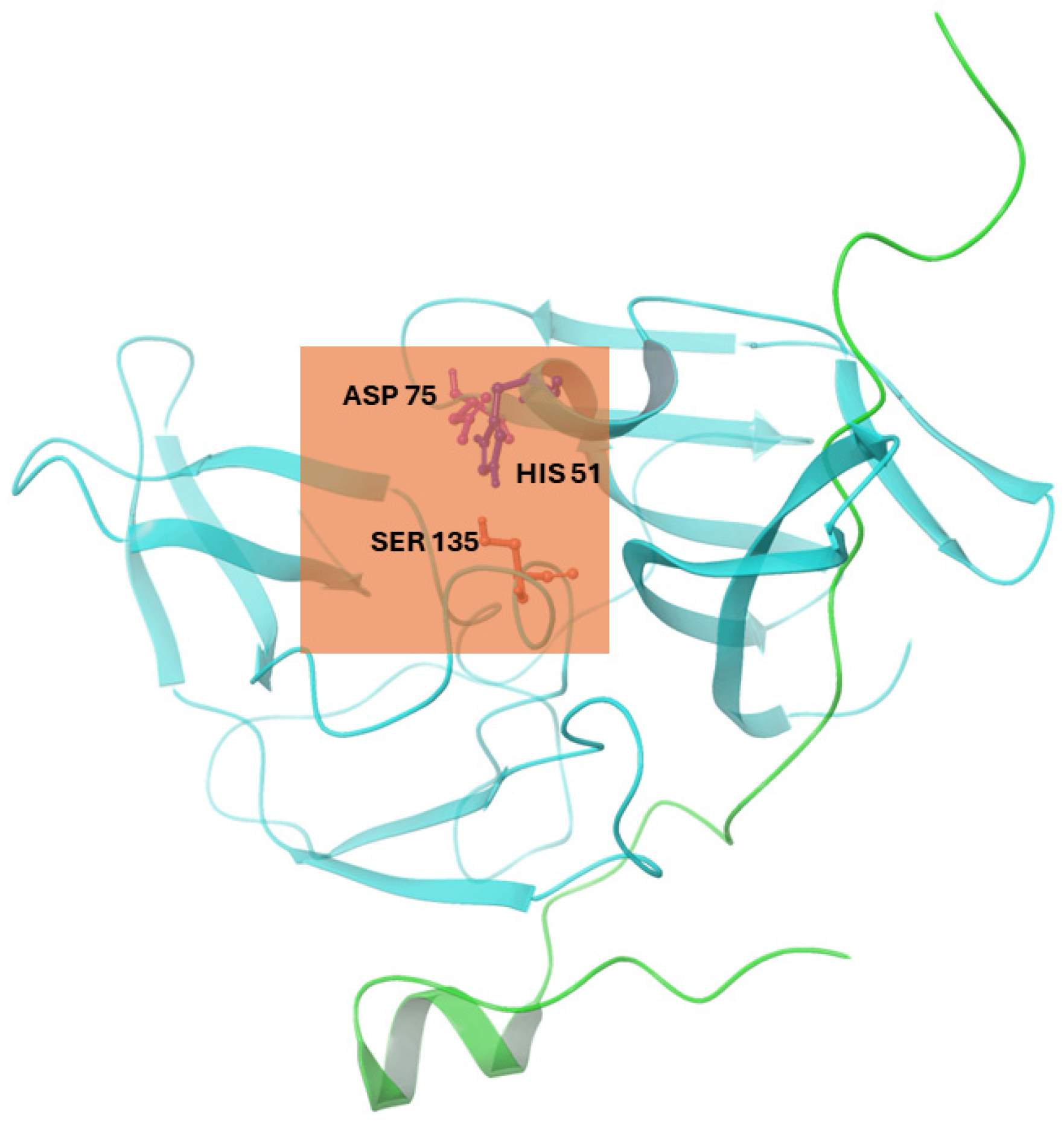
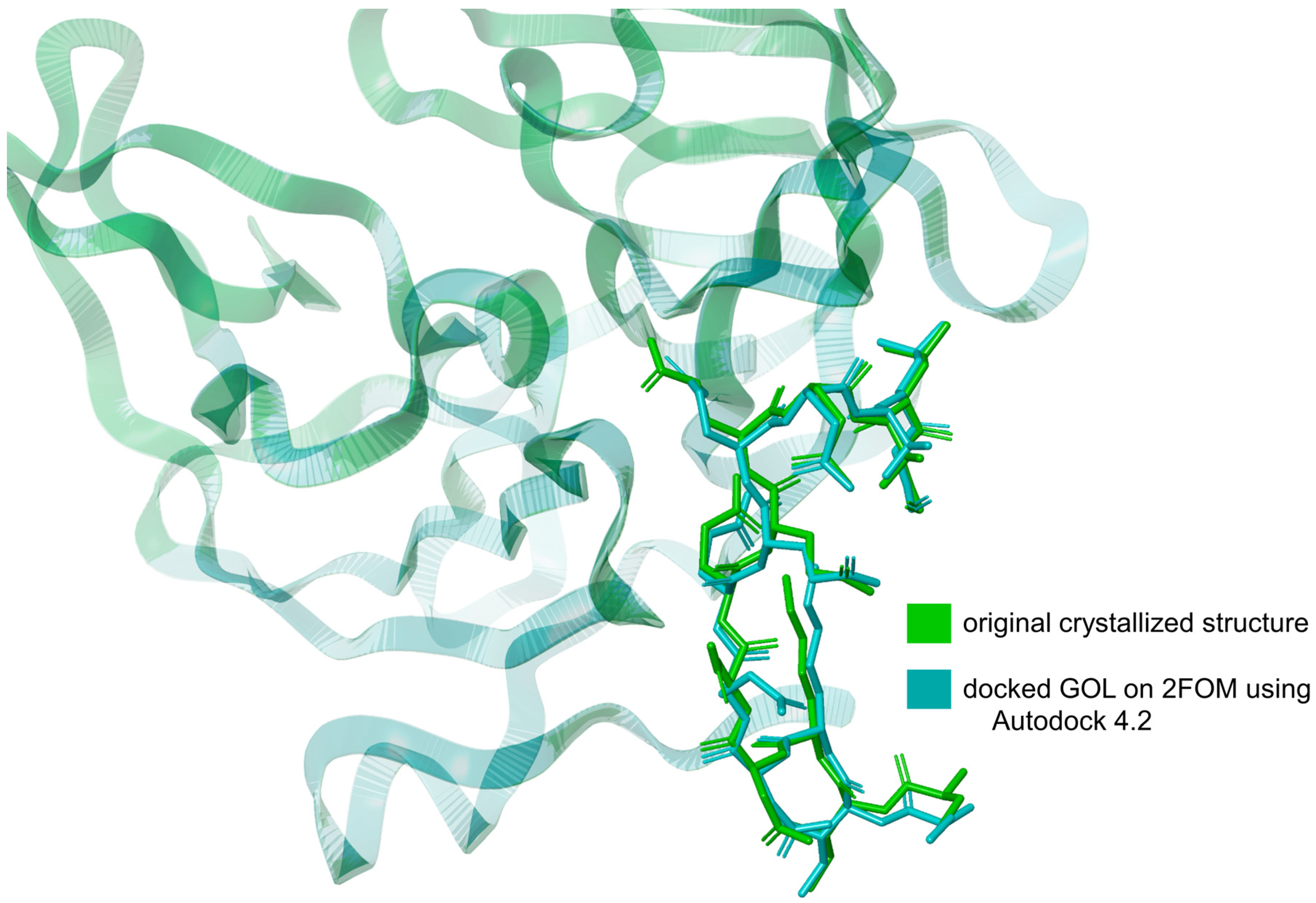
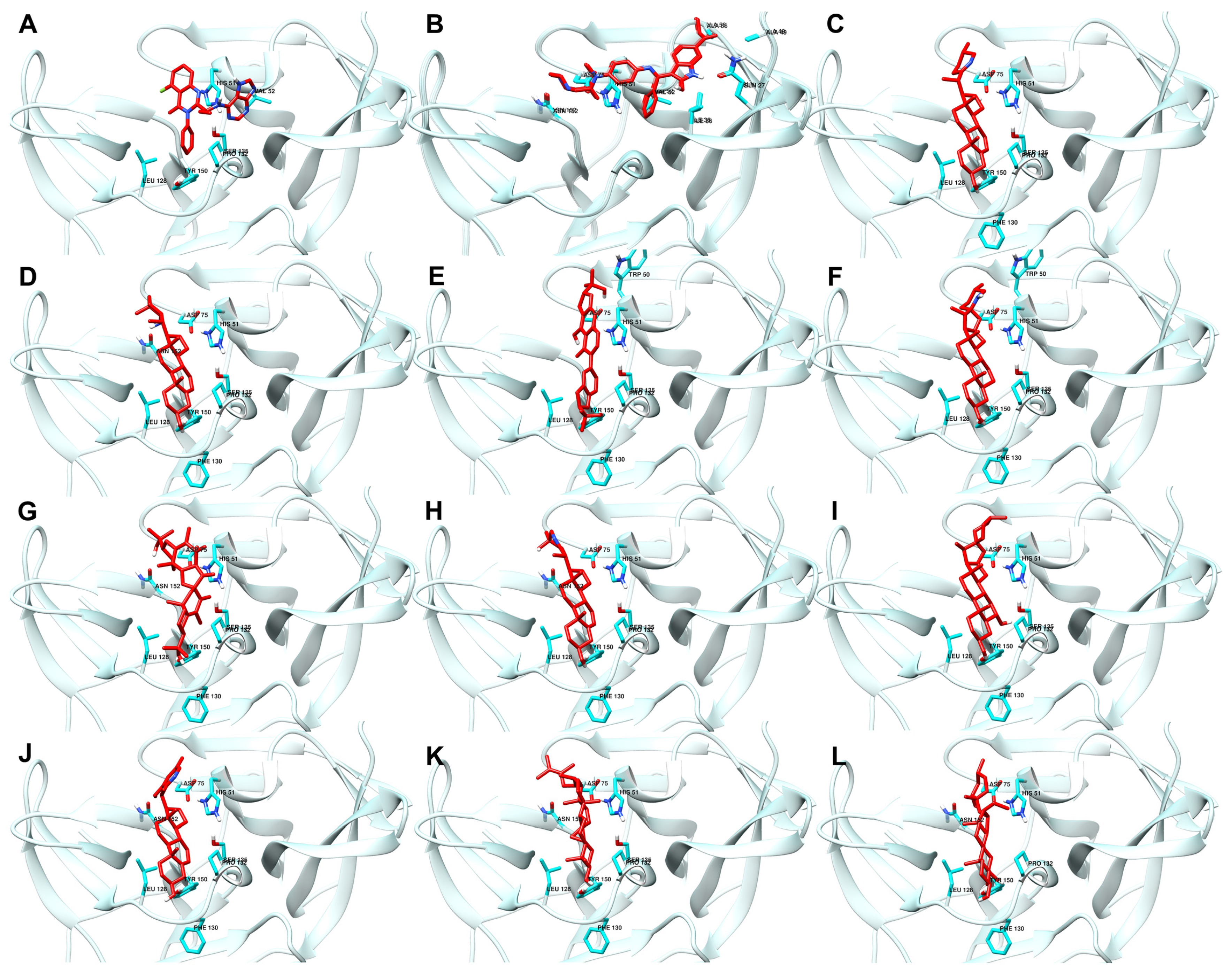
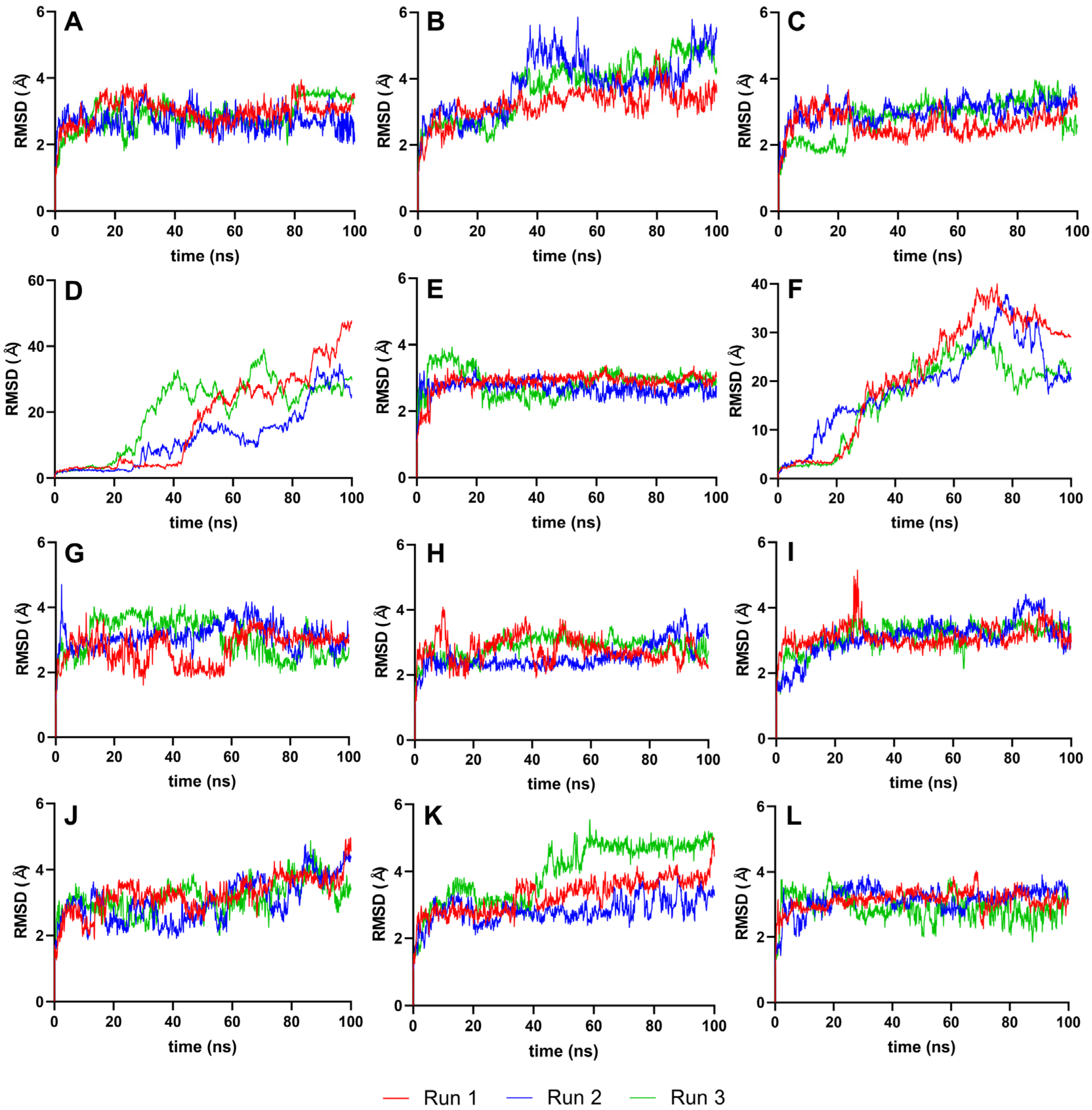


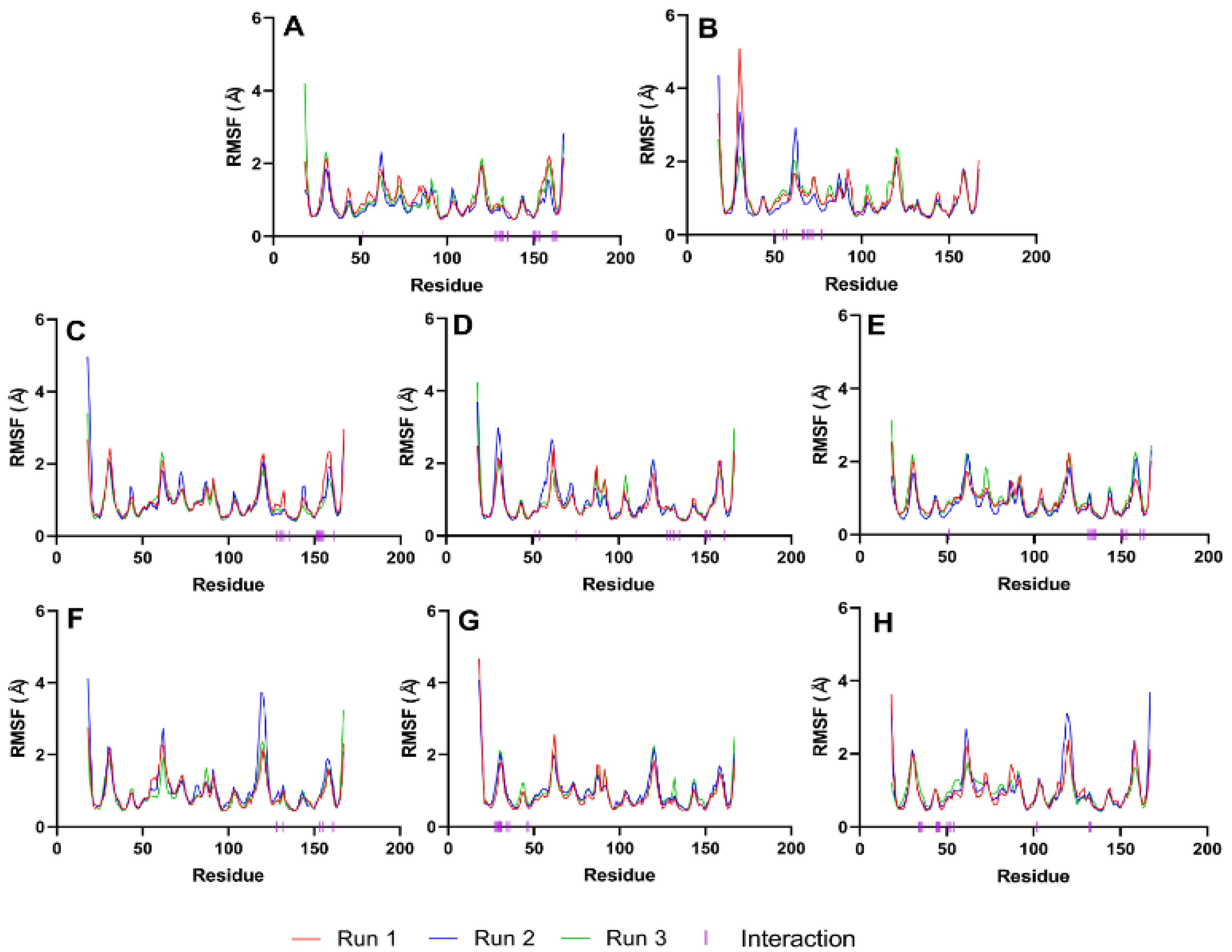


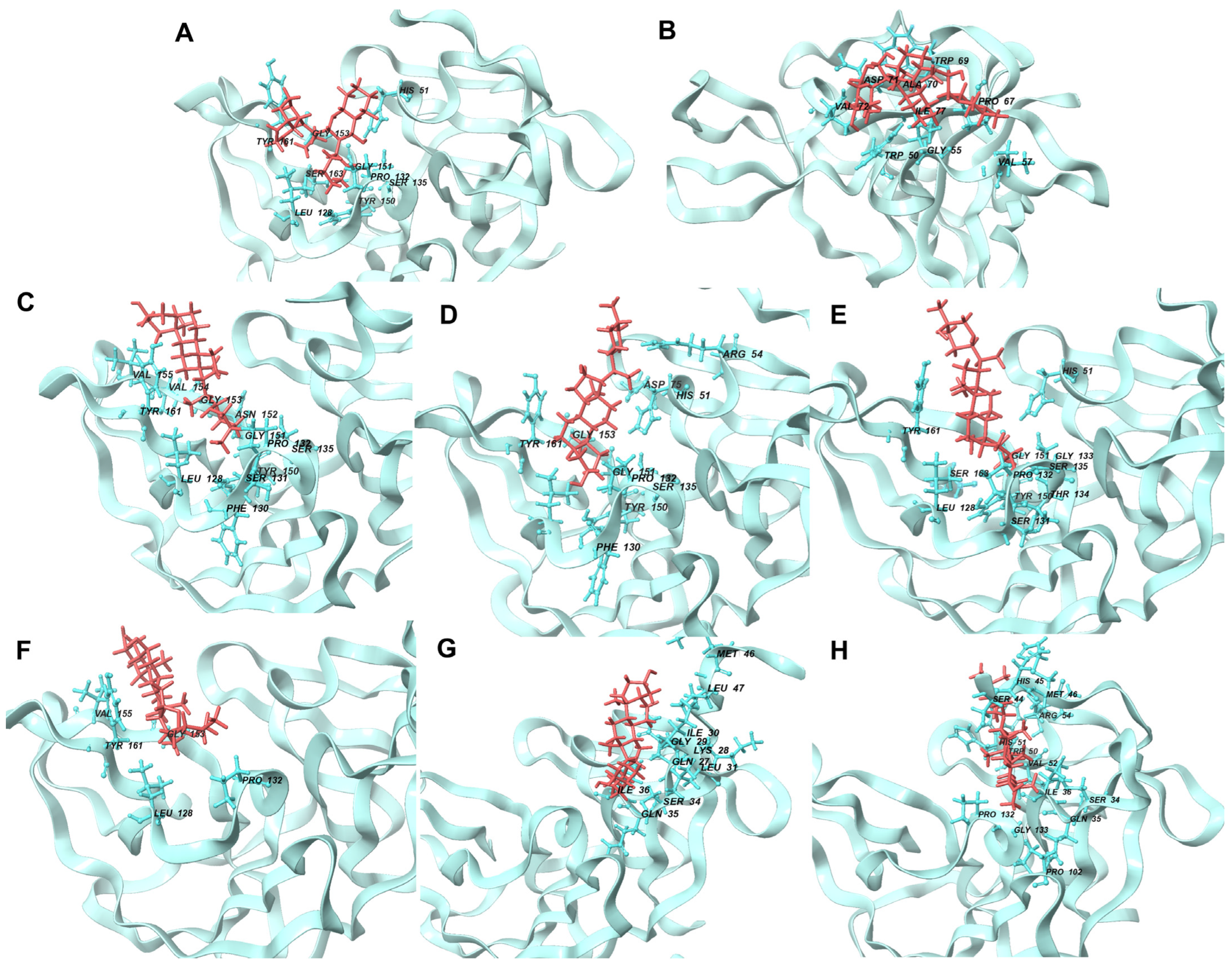
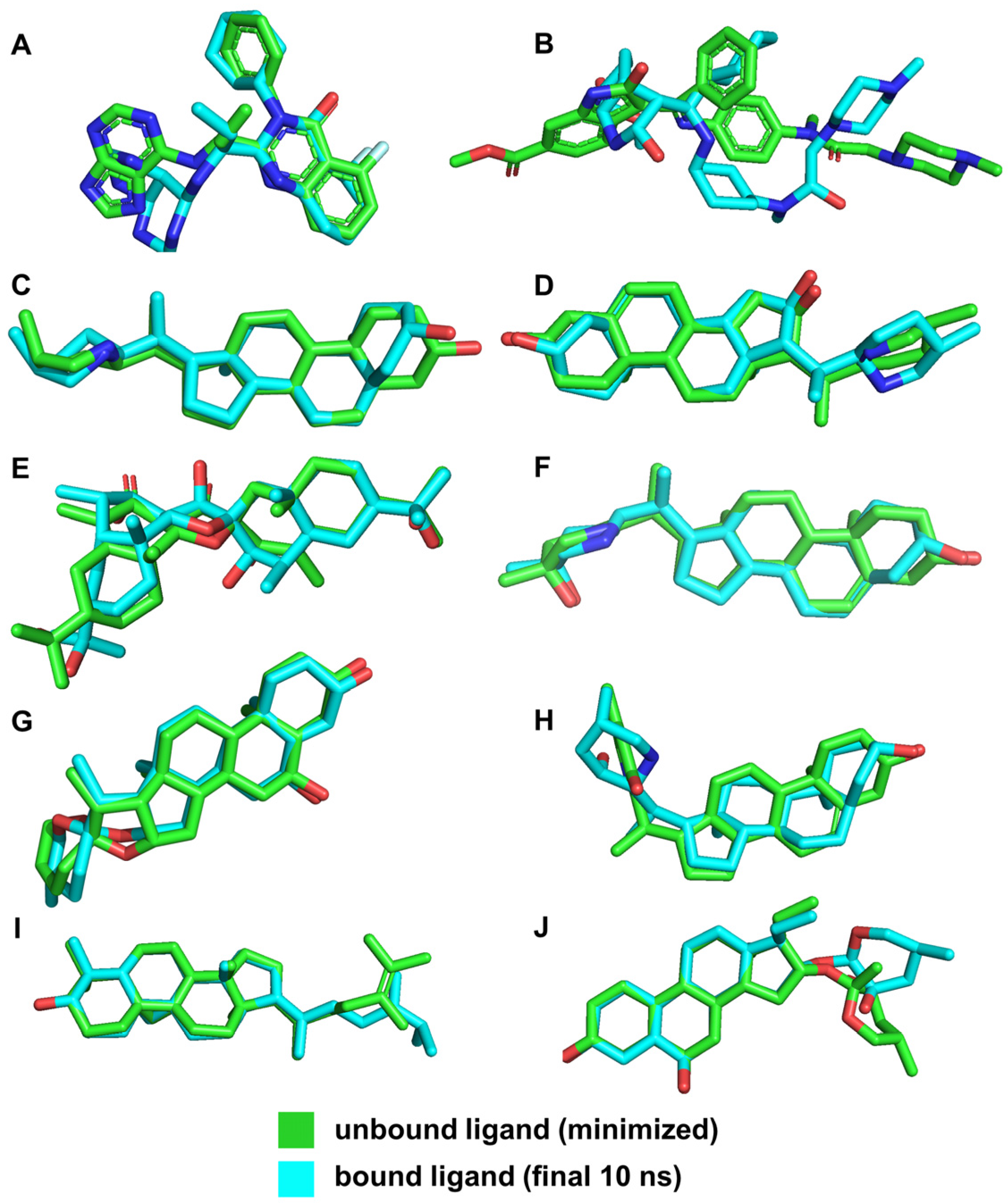
| Source | No. of Ligands | No. of Ligands that Passed SwissADME | No. of Ligands that Passed ChemBioserver 2.0 |
|---|---|---|---|
| Comprehensive Phytochemical Database | 2944 | 1765 | 1265 |
| Database No. | 3-Letter Symbol | Ligand | Plant Source | MW (g/mol) | Docking Score (kJ/mol) |
|---|---|---|---|---|---|
| Reference | IDE | idelalisib | - | 415.4 | −25.522 |
| Reference | NIN | nintedanib | - | 539.6 | −29.790 |
| 15559023 | VER | veramiline | pimacao | 509.6 | −38.953 |
| 10526985 | ISO | isolupinisoflavone | banyan fig | 438.5 | −38.786 |
| 168872 | ETI | etiolin | Turk’s cap lily | 413.6 | −38.242 |
| 65576 | TOM | tomatidine | tomato | 415.7 | −37.865 |
| 101316738 | CAR | carindone | Carandas plum | 512.7 | −36.987 |
| 10549683 | HYD | 25beta-Hydroxyverazine | false daisy | 413.6 | −35.815 |
| 12303065 | CHL | chlorogenin | palm lily | 432.6 | −34.936 |
| 10692897 | ECL | ecliptalbine | false daisy | 409.6 | −34.727 |
| 39 | CYC | cyclobranol | tawa-tawa | 440.7 | −34.309 |
| 52931465 | HON | hongguanggenin | century plant | 464.7 | −33.012 |
| Ligand | Van der Waals Energy (kJ/mol) | Electrostatic Energy (kJ/mol) | Polar Solvation Energy (kJ/mol) | SASA (kJ/mol) | Binding Energy * (kJ/mol) | Mean Binding Energy † | SD † | SEM † |
|---|---|---|---|---|---|---|---|---|
| IDE | −92.068 | −17.2 | 85.545 | −14.642 | −38.365 | −33.82 | 4.04 | 2.33 |
| NIN | −78.447 | −1.298 | 34.100 | −10.063 | −55.709 | −43.21 | 12.53 | 7.23 |
| VER | −104.94 | −6.494 | 43.497 | −13.195 | −80.682 | −53.67 | 24.21 | 13.98 |
| ETI | −107.656 | −32.462 | 94.027 | −13.832 | −59.923 | −52.93 | 10.26 | 5.93 |
| CAR | −80.502 | −2.056 | 50.939 | −11.154 | −42.773 | −41.35 | 1.30 | 0.75 |
| HYD | −103.191 | −27.037 | 81.377 | −13.100 | −61.951 | −54.00 | 12.50 | 7.22 |
| CHL | −82.811 | −1.823 | 31.861 | −10.506 | −63.279 | −52.56 | 13.01 | 7.51 |
| ECL | −76.444 | −9.489 | 39.667 | −10.666 | −56.932 | −44.71 | 12.39 | 7.15 |
| CYC | −111.620 | −4.896 | 60.568 | −14.995 | −70.943 | −61.41 | 12.46 | 7.19 |
| HON | −81.870 | −9.805 | 47.377 | −10.452 | −54.742 | −49.97 | 4.77 | 2.75 |
| Ligand | IDE | NIN | VER | ETI | HYD | CHL | ECL | CYC |
|---|---|---|---|---|---|---|---|---|
| Residue | ||||||||
| Ala 70 | • | |||||||
| Arg 54 | •• | • | ||||||
| Asn 152 | • | • | ||||||
| Asp 71 | • | |||||||
| Asp 75 * | • | |||||||
| Glu 66 | • | |||||||
| Gln 27 | • | |||||||
| Gln 35 | • | • | ||||||
| Gly 29 | • | |||||||
| Gly 55 | • | |||||||
| Gly 133 | •• | • | • | |||||
| Gly 151 | • | • | • | • | ||||
| Gly 153 | • | • | • | • | ||||
| His 45 | • | |||||||
| His 51 * | •• | • | • | |||||
| Ile 30 | • | |||||||
| Ile 36 | • | • | ||||||
| Ile 77 | • | |||||||
| Leu 31 | • | |||||||
| Leu 128 ^ | • | |||||||
| Lys 28 | • | • | • | • | • | |||
| Met 46 | • | |||||||
| Phe 130 | • | • | ||||||
| Pro 67 | • | • | • | • | ||||
| Pro 102 | ||||||||
| Pro 132 ^ | • | |||||||
| Ser 34 | • | • | • | • | • | • | ||
| Ser 44 | • | • | ||||||
| Ser 131 | • | |||||||
| Ser 135* | • | • | • | |||||
| Ser 163 | • | • | • | • | ||||
| Thr 134 | • | • | ||||||
| Trp 50 | • | •• | ||||||
| Trp 69 | • | • | ||||||
| Tyr 150 | ||||||||
| Tyr 161 ^ | • | • | • | • | ||||
| Val 52 | • | • | • | • | • | |||
| Val 57 | • | • | ||||||
| Val 72 | • | |||||||
| Val 154 | ||||||||
| Val 155 | • | |||||||
| Val 162 | • | • |
| Ligand | RMSD (Å) |
|---|---|
| IDE | 1.419 |
| NIN | 3.454 |
| VER | 0.545 |
| ETI | 0.598 |
| CAR | 1.059 |
| HYD | 0.889 |
| CHL | 0.177 |
| ECL | 1.108 |
| CYC | 0.804 |
| HON | 0.210 |
Disclaimer/Publisher’s Note: The statements, opinions and data contained in all publications are solely those of the individual author(s) and contributor(s) and not of MDPI and/or the editor(s). MDPI and/or the editor(s) disclaim responsibility for any injury to people or property resulting from any ideas, methods, instructions or products referred to in the content. |
© 2024 by the authors. Licensee MDPI, Basel, Switzerland. This article is an open access article distributed under the terms and conditions of the Creative Commons Attribution (CC BY) license (https://creativecommons.org/licenses/by/4.0/).
Share and Cite
Cordero, A.M.F.; Gonzales, A.A., III. Using Multiscale Molecular Modeling to Analyze Possible NS2b-NS3 Protease Inhibitors from Philippine Medicinal Plants. Curr. Issues Mol. Biol. 2024, 46, 7592-7618. https://doi.org/10.3390/cimb46070451
Cordero AMF, Gonzales AA III. Using Multiscale Molecular Modeling to Analyze Possible NS2b-NS3 Protease Inhibitors from Philippine Medicinal Plants. Current Issues in Molecular Biology. 2024; 46(7):7592-7618. https://doi.org/10.3390/cimb46070451
Chicago/Turabian StyleCordero, Allen Mathew Fortuno, and Arthur A. Gonzales, III. 2024. "Using Multiscale Molecular Modeling to Analyze Possible NS2b-NS3 Protease Inhibitors from Philippine Medicinal Plants" Current Issues in Molecular Biology 46, no. 7: 7592-7618. https://doi.org/10.3390/cimb46070451
APA StyleCordero, A. M. F., & Gonzales, A. A., III. (2024). Using Multiscale Molecular Modeling to Analyze Possible NS2b-NS3 Protease Inhibitors from Philippine Medicinal Plants. Current Issues in Molecular Biology, 46(7), 7592-7618. https://doi.org/10.3390/cimb46070451


_Kim.png)



